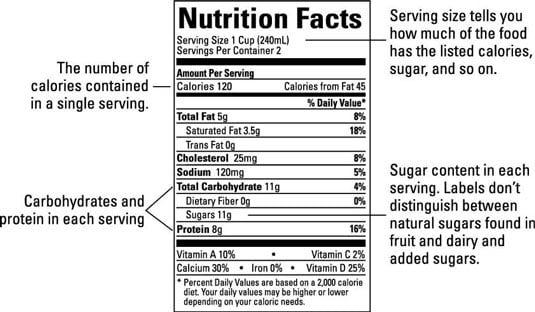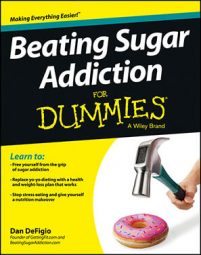The nutrition facts label is your key to uncovering the truth about the food and amount of sugar inside. The nutrition facts label shows you the serving size, the calorie count, the basic nutrition breakdown (protein, carbs, fat, sugar, sodium, and so on), and, most important, the ingredients.

Even though most of your healthiest meals consist of whole foods without labels, you should watch out for trouble on the nutrition labels of anything you buy that comes wrapped or boxed — bread, crackers, nuts, and condiments, for example.
Here are several things to watch out for on nutrition labels:
Enriched flour: Even baked goods that prominently display whole wheat or whole grain on the packaging are often made of mostly enriched flour, with just a sprinkling of whole-grain flour added in. Read the ingredients list to see whether the primary flour is enriched flour, and look for products with organic whole-grain flours as the first ingredient instead.
High sugar content: Replace any packaged food with more than 10 grams of sugar per serving with a lower-sugar alternative (the exception to this is unsweetened fruit, which contains more than 10 grams of natural sugar per serving).
Note that the nutrition facts panel doesn’t differentiate between naturally occurring sugars (such as those in fruit and dairy) and added sugars (such as high-fructose corn syrup).
Trans fats: If you see the word hydrogenated anywhere in the ingredients, put the item back on the shelf.
Pay attention to the serving size noted on the nutrition label of packaged foods. Measure out a serving to see how that compares to the amount that you normally eat; you may find that without checking, you ordinarily eat many servings’ worth of calories and sugar!
Some food labels display claims or descriptions like sugar-free or good source of fiber. The FDA has specific requirements for food label claims.
| If the Label Says | Then It Has This (per Serving) |
|---|---|
| Low calorie | 40 calories or less |
| Calorie free | Less than 5 calories |
| Low fat | 3 grams or less of fat |
| Fat free | Less than 1/2 gram of fat |
| Low saturated fat | 1 gram or less of saturated fat |
| Low cholesterol | 20 mg or less of cholesterol and 2 grams or less of saturated fat |
| Cholesterol free | Less than 2 mg of cholesterol and 2 grams or less of saturated fat |
| Low sodium | 140 mg or less of sodium |
| Very low sodium | 35 mg or less of sodium |
| Sugar free | Less than 1/2 gram of sugar |
| Good source of fiber | 2.5 grams or more of fiber |
| Lean (meat, poultry, and seafood) | Less than 10 grams of total fat, 4.5 grams of saturated fat, and 95 mg cholesterol |
| Extra lean (meat, poultry, and seafood) | Less than 5 grams of total fat, 2 grams of saturated fat, and 95 mg of cholesterol |
| High, rich in, or excellent source of | Contains 20% or more of the daily value |
| Good source, contains, or provides | Contains 10–19% of the daily value |
| More, fortified, enriched, added, extra, or plus | 10% or more of the daily value; may only be used for vitamins, minerals, protein, dietary fiber, and potassium |

